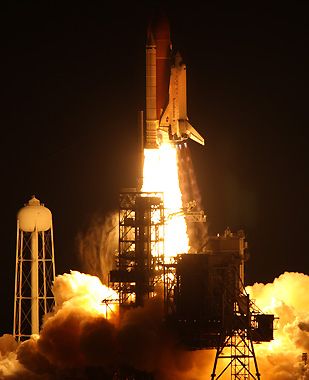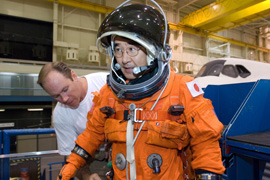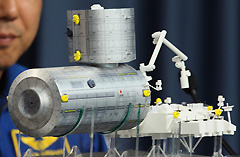Shuttle blasts Japan lab into space
Shuttle will deliver first Japanese-made module to international space station.

“We’d like to say konnichiwa, domo arigato and banzai,” shuttle commander Dominic Gorie said shortly before liftoff, acknowledging Japan’s central role in the mission.
Kibo’s addition forms the centrepiece of Japan’s commitment to the space station and, in the words of mission controllers, makes the orbiting platform “the one place where east and west do meet”.
Delays
The $2.4bn Japanese space lab was first conceived two decades ago and has been hit by a series of delays, mostly caused by the 2003 Columbia shuttle disaster which put a hold on launches for two years.
| Kibo: Japan’s space lab |
|
Japan‘s first permanent manned presence in space
To be delivered into orbit by three shuttle flights
Scheduled completion in May 2008
Will conduct experiments on effect of microgravity
Includes platform with robotic arm to expose experiments to space |
Japanese astronaut Takao Doi, is among the seven-strong crew on Endeavour’s mission to deliver the first part of Kibo to the ISS.
“I understand that this is a really big event for Japan because it’s just like we’ll have a little Japanese land in space,” Doi, who is on his second shuttle flight, told reporters at the weekend.
He admitted the first part of the laboratory was a tight squeeze, offering about as much space as a “walk-in closet”, but when completed next year Kibo will be the largest of four research modules added to the ISS.
For Japan the launch of Kibo gives the country a prized spot alongside the United States, Russia and Europe after committing more than $10bn to the ISS project.
Last month, the European Columbus lab was attached to the station, and the addition of Kibo finally brings the platform’s multinational status into reality.
‘Global village’
 |
| Japanese astronaut Takao Doi will oversee the delivery of Kibo to the ISS [Photo: Nasa] |
Mission controllers said Tuesday’s launch would mark an important step in constructing “the first global village in space”.
The first part of Kibo, dubbed ELM-PS, will carry an equipment and storage room for the Japanese lab and weighs 4.2 tonnes.
The main section – a massive 11.2-metre-long, bus-sized cylinder weighing almost 16 tonnes – is scheduled for launch in late May.
The final section, an outdoor porch with robotic arms for tending to science experiments, is due to fly next year.
Once operational the lab will carry out research into the effects of micro-gravity.
Endeavour’s crew is scheduled to conduct at least five space walks during its 12 days attached to the ISS, as Nasa looks to ramp up construction efforts on the space station before the ageing space shuttle fleet is retired in 2010.
With a mission length of 16 days, Endeavour’s flight will be the longest-ever by a shuttle visiting the space station.
The mission is the second of six planned shuttle launches this year, all but one of which will visit the space station.
The mission will also deliver a Canadian two-armed robot known as Dextre, designed to assist spacewalking astronauts at the orbiting complex.
